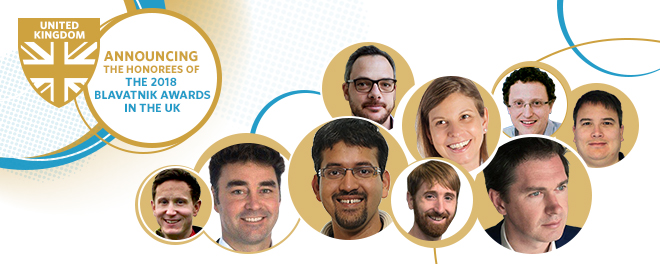
The Blavatnik Family Foundation and the New York Academy of Sciences today announced the Laureates and Finalists of the 2018 Blavatnik Awards for Young Scientists in the United Kingdom.
One Laureate in each of the three Blavatnik Awards categories—Life Sciences, Physical Sciences & Engineering, and Chemistry—will each receive an unrestricted prize of US$100,000; additionally, two Finalists in each category will each receive unrestricted prizes of US$30,000. The Blavatnik Awards in the UK are the largest unrestricted cash prizes available exclusively to young scientists in the UK.
The Blavatnik Awards, established by the Blavatnik Family Foundation in the United States in 2007 and administered by the New York Academy of Sciences, honour and support exceptional early-career scientists and engineers aged 42 years or younger. In 2018, the Awards recognise the first cohort of international honourees in the United Kingdom and in Israel. To date, the Blavatnik Awards have conferred prizes totalling US$5 million, honouring 220 outstanding young scientists and engineers.
In this inaugural year of the Blavatnik Awards in the UK, 124 nominations were received from 67 academic and research institutions across England, Scotland, Wales, and Northern Ireland. A distinguished jury of leading senior scientists and engineers from throughout the UK selected the Laureates and Finalists.
The inaugural Blavatnik Awards Laureates and Finalists in the UK will be honoured at a gala dinner and ceremony at the Victoria and Albert Museum in London on 7th March, 2018.
To follow the progress of the Blavatnik Awards, please visit the Awards’ website or follow us on Facebook and Twitter (@BlavatnikAwards). For media requests, please contact Kamala Murthy [kmurthy@nyas.org; +1-212-298-3740] or Alex Pack [apack@brunswickgroup.com; +44 (0) 7469 083505].
The 2018 Blavatnik Awards UK Laureates are:
LIFE SCIENCES
Dr. M. Madan Babu, Medical Research Council (MRC) Laboratory of Molecular Biology.
Dr. Babu's work has pioneered techniques from genomics, bioinformatics and structural biology to understand the molecular logic of key proteins and protein motifs. His work on G-protein–coupled receptors (GPCRs) — which are among the most common drug target — reveals how these molecules function and will aid in developing more specific, targeted pharmaceuticals in this age of personalised medicine.
CHEMISTRY
Prof. Andrew L. Goodwin, University of Oxford.
Prof. Goodwin is a world leader in the study of the chemistry and physics of functional materials, which have unique magnetic, optical, and electrical properties. His work has revealed the role of structural disorder in these materials, and how this phenomenon can explain unique material properties such as negative thermal expansion, negative compressibility, and exotic magnetic states.
PHYSICAL SCIENCES & ENGINEERING
Prof. Henry Snaith, University of Oxford.
Prof. Snaith’s pioneering work in developing new, low-cost and high-efficiency solar cells based on metal halide perovskite materials has not only initiated a new research field now studied by scientists around the world, but also has the potential to deliver solar energy to the market at a fraction of the cost of currently used materials.
“In the spirit of the United Kingdom's tradition of scientific excellence and pursuit of knowledge, we are pleased to recognise and support these inaugural Blavatnik Awards Laureates and Finalists as they pursue their careers in advancing their respected fields,” said Sir Leonard Blavatnik, Founder and Chairman of Access Industries and head of the Blavatnik Family Foundation. "Through the promise that they have already demonstrated, we are confident they will continue pushing the boundaries of discovery and innovation."
“The community of previous Blavatnik Awards honourees is an incredible group of the smartest scientific minds. We are extremely proud to bring the Blavatnik Awards programme to the United Kingdom, recognising outstanding young scientists leading their respective fields,” said Ellis Rubinstein, President and CEO of the New York Academy of Sciences and Chair of the Awards’ Scientific Advisory Council. "In its first year, we witnessed terrific enthusiasm from the UK’s scientific community and hope to see even more institutions nominate their top Faculty-level scientists in the coming years.”
2018 Blavatnik Awards UK Finalists
The following scientists have been named Finalists:
LIFE SCIENCES
Prof. Timothy Behrens, University of Oxford; honorary Principal Investigator, University College London (UCL).
Prof. Behrens investigates the biology of the brain that underlies human behaviour. By combining mathematical models with behavioural experiments and neural recordings, he has uncovered at a cellular level how the brain stores abstract information about relationships between things in the world, and how we use this mental map in decision-making. His discoveries have applications in neural network computing and artificial intelligence, but also on our understanding of cognition and mental health.
Dr. John Briggs, Medical Research Council (MRC) Laboratory of Molecular Biology.
Prof. Briggs uses cryo-electron tomography combined with fluorescence imaging and other techniques to visualise the molecular assembly processes of viral particles such as HIV at unprecedented resolution. His work provides detailed insight into the mechanisms of action of viruses, which stands to have a broad impact on drug development and our understanding of disease.
CHEMISTRY
Dr. Robert Hilton, Durham University.
Dr. Hilton’s research has provided new insights into Earth’s long-term carbon cycle and the natural processes that transfer carbon dioxide between the atmosphere and rocks. His research has uncovered how erosion of land in the form of earthquakes and resulting landslides, weathering of organic carbon in rocks, and the export of carbon by rivers can have an impact on atmospheric carbon dioxide concentration.
Prof. Philipp Kukura, University of Oxford.
Prof. Kukura is a physical chemist recognised for pioneering efforts in single-molecule scale microscopy and spectroscopy that enable the study of native, unlabelled molecules in real time. His particular focus is on biological macromolecules such as proteins as they interact with drugs or self-assemble with each other.
PHYSICAL SCIENCES & ENGINEERING
Dr. Claudia de Rham, Imperial College London.
Dr. de Rham’s work has revolutionised our understanding of the nature of gravity, founding a new field of study that connects cosmology with particle physics and the nature of spacetime itself. The implications of her work are extremely wide-ranging, from our understanding of the fundamental evolution of the universe to the quantum nature of gravity.
Prof. Andrew Levan, University of Warwick.
Prof. Levan is a leader in the field of extragalactic research, primarily aimed at understanding extreme transient events such as gamma-ray bursts, supernovae, and their roles as cosmological probes. He studies events such as the most-distant gamma-ray bursts, which unveil details of the earliest galaxies, and was the first to identify the signature of a star destroyed through a close encounter with a supermassive black hole.
About the 2018 Blavatnik Awards UK Laureates
Dr. M. Madan Babu
2018 Blavatnik Awards in the UK Laureate in Life Sciences
Programme Leader, Computational Biology & Bioinformatics
MRC Laboratory of Molecular Biology
Postdoctoral Scientist, National Institutes of Health, USA
Ph.D., University of Cambridge, UK
B. Tech., Anna University, India
 Prof. Babu’s multi-disciplinary work brings together techniques from structural biology, genomics, and bioinformatics to analyse biological systems at many levels. In one achievement using this approach, Prof. Babu has uncovered mechanistic details of a class of proteins called G-protein–coupled receptors (GPCRs). These proteins are implicated in over a hundred human disorders, and drugs targeting GPCRs represent nearly 30% of all drug sales. Prof. Babu and his team identified key aspects of GPCR biology that will aid in developing more specific, targeted pharmaceuticals. Additionally, Prof. Babu has shown that many GPCRs targeted by common drugs are highly variable in the human population, such that patients with different variants are likely to have different responses to the same drug. This work represents a significant contribution to the relatively new field of personalised medicine.
Prof. Babu’s multi-disciplinary work brings together techniques from structural biology, genomics, and bioinformatics to analyse biological systems at many levels. In one achievement using this approach, Prof. Babu has uncovered mechanistic details of a class of proteins called G-protein–coupled receptors (GPCRs). These proteins are implicated in over a hundred human disorders, and drugs targeting GPCRs represent nearly 30% of all drug sales. Prof. Babu and his team identified key aspects of GPCR biology that will aid in developing more specific, targeted pharmaceuticals. Additionally, Prof. Babu has shown that many GPCRs targeted by common drugs are highly variable in the human population, such that patients with different variants are likely to have different responses to the same drug. This work represents a significant contribution to the relatively new field of personalised medicine.
In a parallel body of work, Prof. Babu has also made fundamental discoveries regarding protein structure. About 40% of human proteins have a region that is unstructured compared to normal proteins—these so-called intrinsically disordered regions (IDRs) have puzzled structural biologists for decades. Through a combination of computational approaches, big-data analysis, machine learning, and experimental validation, Prof. Babu and his team helped to establish the roles of IDRs in health and disease. Together, these studies shed light on key classes of proteins that are integral to human health.
Prof. Andrew Goodwin
2018 Blavatnik Awards in the UK Laureate in Chemistry
Professor of Materials Chemistry, Inorganic & Solid-State Chemistry University of Oxford
Junior Research Fellow, University of Cambridge, UK
Ph.D., Mineral Physics, University of Cambridge, UK
Ph.D., Inorganic Chemistry, University of Sydney, Australia
B.Sc., Chemistry & Pure Mathematics, University of Sydney, Australia
 Prof. Goodwin is considered a world leader in probing, investigating, and quantifying the effects of disorder and flexibility in materials that are traditionally thought of as highly ordered and uniform at an atomic scale. His laboratory utilizes advanced diffraction and modelling techniques to probe disordered materials and subsequently produce new, tailored materials that display unique properties.
Prof. Goodwin is considered a world leader in probing, investigating, and quantifying the effects of disorder and flexibility in materials that are traditionally thought of as highly ordered and uniform at an atomic scale. His laboratory utilizes advanced diffraction and modelling techniques to probe disordered materials and subsequently produce new, tailored materials that display unique properties.
As an example of his approach, most materials will expand upon heating and shrink when compressed; however, Prof. Goodwin has discovered that by careful control of the disorder within the structure of a substance, the opposite can occur—a material can be made that will shrink upon heating (negative thermal expansion) and expand when compressed (negative linear compressibility). These counterintuitive processes can be exploited in the design of heat-resistant materials, advanced pressure sensors, artificial muscles, and even body armour. Additionally, Prof. Goodwin has played a key role in the structural analysis of amorphous materials, which, in the case of amorphous calcium carbonate, the key structural component in bones and shell, led to a complete understanding of the ability of organisms to nucleate different crystalline structures from the same biomineral precursor.
Prof. Henry Snaith
2018 Blavatnik Awards in the UK Laureate in Physical Sciences & Engineering
Professor of Physics; Group Leader, Photovoltaics and Optoelectronics Device Group, Department of Physics
University of Oxford
Postdoctoral Scientist, École Polytechnique Fédérale de Lausanne (EPFL), Switzerland
Postdoctoral Scientist, University of Cambridge, UK
Ph.D., Physics, University of Cambridge, UK
M.Sci., Physics, University of Bristol, UK
Junior Research Fellow, University of Cambridge, UK
 Prof. Snaith's research has striven to develop new, low-cost photovoltaic technologies based on easily processed materials, which promise to deliver solar energy at a fraction of the cost of current solar technologies. Since 2012, his research has transformed research in the photovoltaics community. He found that metal halide perovskite materials, which had been overlooked for decades because of their very low solar energy conversion efficiency, can be employed in a previously overlooked configuration to create highly efficient solar cells. He has since raised the energy conversion efficiency of the perovskite materials to over 22% when used alone in solar cells, and more recently to 25% by combining perovskites with crystalline silicon cells. Potentially, the perovskite-on-silicon combined cells may deliver a photovoltaic technology capable of surpassing the 30% efficiency mark, making them very promising for industrial applications.
Prof. Snaith's research has striven to develop new, low-cost photovoltaic technologies based on easily processed materials, which promise to deliver solar energy at a fraction of the cost of current solar technologies. Since 2012, his research has transformed research in the photovoltaics community. He found that metal halide perovskite materials, which had been overlooked for decades because of their very low solar energy conversion efficiency, can be employed in a previously overlooked configuration to create highly efficient solar cells. He has since raised the energy conversion efficiency of the perovskite materials to over 22% when used alone in solar cells, and more recently to 25% by combining perovskites with crystalline silicon cells. Potentially, the perovskite-on-silicon combined cells may deliver a photovoltaic technology capable of surpassing the 30% efficiency mark, making them very promising for industrial applications.
Another huge benefit of these perovskite solar cells is their low cost, thanks to the fact they can be processed from solution and that the solar cells are simple layered devices. In addition, Prof. Snaith has significantly improved the long-term stability of perovskite solar cells and significantly advanced our fundamental understanding of the physics of these perovskite semiconductors, which has helped broaden the application range of these materials to include light emission as well as radiation detection, memory, and sensing. Prof. Snaith’s work has led in a short period to a very promising new sustainable energy generation option that could quickly surpass our existing solar-cell technologies.
###
About the Blavatnik Family Foundation
The Blavatnik Family Foundation is an active supporter of many leading educational, scientific, cultural, and charitable institutions in the United States, the United Kingdom, Israel, and throughout the world. Recipients of Foundation support include Oxford University, Harvard University, Yale University, Tel Aviv University, Stanford University, New York University, the New York Academy of Sciences, Tate, Victoria and Albert Museum, Carnegie Hall, the Royal Opera House, the Hermitage Museum, Lincoln Center, Jewish charitable organizations, and countless other philanthropic institutions. The Foundation is headed by Sir Leonard Blavatnik, a major American and British entrepreneur and philanthropist. Sir Leonard is the Founder and Chairman of Access Industries, a privately-held U.S. industrial group with global strategic interests in natural resources and chemicals, media and telecommunications, venture capital, and real estate. For more detailed information, please visit: www.accessindustries.com.
About the New York Academy of Sciences
The New York Academy of Sciences is an independent, not-for-profit organization that since 1817 has been driving innovative solutions to society’s challenges by advancing scientific research, education, and policy. Throughout its history, the Academy's Membership has featured thinkers and innovators from all walks of life, including U.S. Presidents Jefferson and Monroe, Thomas Edison, Lord Kelvin, Charles Darwin, Margaret Mead, Louis Pasteur, and over 130 Nobel Laureates. Today, the Academy numbers over 20,000 Members in 100+ countries, with a President's Council that includes 37 Nobel Laureates, and a distinguished Board of Governors comprised of leaders from business, academia, and philanthropy. It is also young and dynamic with nearly 10,000 post-doctoral, post-graduate, undergraduate, and gifted high school student Members. Through collective action, the Academy is partnering with the United Nations to address the Global Goals, advising national leaders, and organizing public-private partnerships to address the grand challenges of the planet. Please visit us online at www.nyas.org and follow us on Twitter at @NYASciences.
###